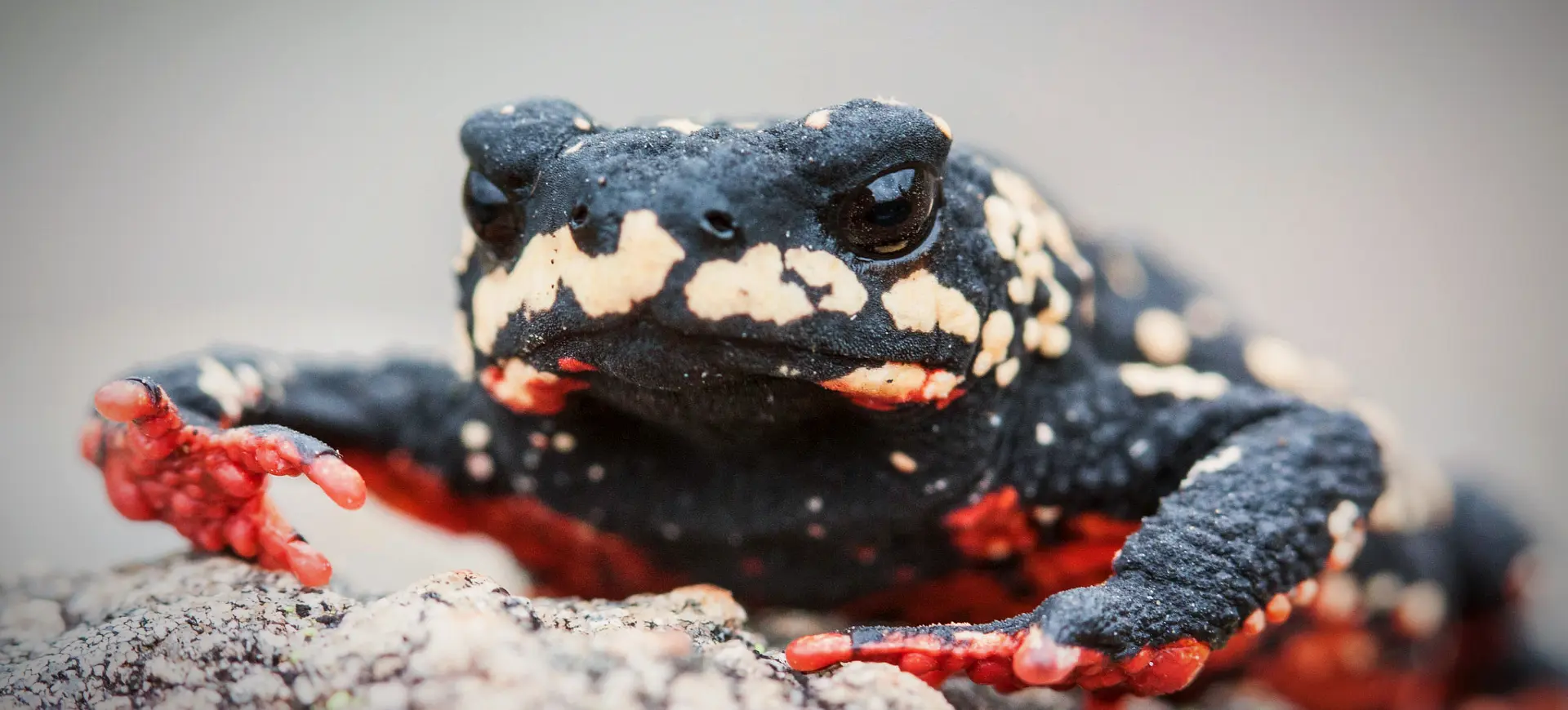Overview
The cane toad (Rhinella marina) is a large, highly adaptable amphibian native to Central and South America but has been introduced to many other regions. It was intentionally released in places such as Australia and various Pacific islands to control agricultural pests, but it has since become an invasive species. Cane toads are known for their toxic skin secretions, which deter most predators but have had devastating effects on native wildlife where introduced. Their populations have expanded rapidly in non-native habitats due to their high reproductive rate and ability to thrive in diverse environments.
Cane toads have a warty, robust body with dry, rough skin that varies in color from grayish-brown to olive or reddish hues. They have large, parotoid glands behind their eyes, which secrete a potent toxin called bufotoxin when threatened. Unlike many other toad species, cane toads have relatively short legs, making them better suited for walking and hopping rather than long jumps. Their large size and defensive chemicals make them one of the most successful invasive amphibians in the world.
This highly opportunistic species can be found in a variety of habitats, including forests, grasslands, urban areas, and agricultural fields. It is most active at night when it hunts insects and small vertebrates, often being drawn to artificial light sources that attract prey. Due to their toxic defenses, cane toads have few natural predators in introduced regions, allowing their populations to grow unchecked. They are resilient to harsh conditions, tolerating extreme temperatures, dehydration, and polluted environments better than many native amphibians.
Taxonomy
Kingdom
Phylum
Class
Order
Family
Genus
Species
Type
Current distribution:
The cane toad's natural range includes northern South America, Central America, and parts of the southern United States, such as Texas and Florida. However, they have been widely introduced to regions such as Australia, the Philippines, Hawaii, and several Caribbean islands. They have become a major ecological threat in Australia, spreading across vast areas and negatively impacting native species through predation and poisoning. Their populations continue to expand in many non-native regions due to their high reproductive rates and lack of natural predators.
Their spread is facilitated by their ability to survive in various environmental conditions, including urban and agricultural settings. In some areas, efforts have been made to control their numbers through population management programs and predator education. Despite these efforts, their populations remain robust and are considered one of the most harmful invasive species in many ecosystems. Their presence has led to declines in native predators, such as quolls, snakes, and freshwater crocodiles that attempt to consume them and succumb to their toxins.
Physical Description:
Cane toads are among the largest toads in the world, with adult specimens reaching impressive sizes and weights. Their skin is thick and bumpy, covered in warts that secrete a milky, toxic substance when the toad feels threatened. Their coloration ranges from grayish-brown to reddish or yellowish hues, often mottled with dark patches for camouflage in their surroundings. Their eyes are large and golden with horizontal pupils, providing good night vision for nocturnal hunting.
They have short, sturdy limbs that make them better suited for walking rather than the long jumps typical of smaller frog species. Their front limbs are relatively small, while their powerful hind legs allow short hops and stability on rough terrain. The most distinctive feature of the cane toad is its prominent parotoid glands behind the eyes, which release toxic secretions harmful to predators. Unlike many other toads, they lack adhesive pads on their toes, meaning they are not skilled climbers.

Lifespan: Wild: ~10 Years || Captivity: ~15 Years

Weight: Male: 0.8–2.2 lbs (0.4–1 kg) || Female: 1.3–4.4 lbs (0.6–2 kg)

Length: Male: 4.5–7 in (11–18 cm) || Female: 6–9 in (15–23 cm)

Top Speed: 5 mph (8 km/h)
Characteristic:
Native Habitat:
Cane toads are originally native to tropical and subtropical regions of Central and South America, where they inhabit diverse environments ranging from rainforests to dry savannas. They are highly adaptable and can be found near bodies of water such as ponds, rivers, and swamps, which they use for breeding. Their ability to tolerate humid and arid conditions allows them to thrive in regions with seasonal rainfall patterns. In their native range, they coexist with natural predators that help keep their populations in check.
Due to their adaptability, cane toads have successfully established themselves in various non-native habitats, including agricultural lands, urban areas, and coastal regions. They are frequently found in human-modified landscapes, where they exploit food sources such as pet food and garbage. Their breeding sites include shallow pools, drainage ditches, and even artificial water containers, making them well-suited to expanding into new areas. Unlike some amphibians, they are highly resistant to dehydration, allowing them to survive in environments with limited water availability.
Climate Zones:
Biogeographical Realms:
Continents:
Diet:
Diet & Feeding Habits:
Cane toads are generalist feeders with an opportunistic diet, consuming various prey items. Their primary diet consists of insects such as beetles, ants, termites, and grasshoppers, but they will also eat small vertebrates, including rodents, birds, and reptiles. They have been observed consuming pet food, carrion, and even smaller cane toads, displaying a remarkable ability to exploit different food sources. Their feeding strategy involves ambush hunting, where they remain motionless before quickly striking at passing prey with their sticky tongues.
In non-native regions, cane toads have significantly impacted local ecosystems by preying on native species and competing with indigenous amphibians. Their voracious appetite allows them to outcompete many native predators, further exacerbating their invasive status. They are particularly drawn to artificial lights at night, where they feed on insects attracted to illumination. In captivity, they are commonly fed a diet of crickets, mealworms, and pinky mice, supplemented with vitamins to ensure proper nutrition.
Mating Behavior:
Mating Description:
Cane toads have a prolonged breeding season, with reproduction occurring primarily during the rainy season in warm climates. Males call to attract females using a deep, throaty croaking sound near water bodies. Once a female selects a mate, the male grasps her in an amplexus position, fertilizing the eggs externally as she lays them. A single female can lay up to 30,000 eggs in long gelatinous strands, which hatch within a few days.
The tadpoles develop rapidly, often metamorphosing into toadlets within 4–8 weeks, depending on environmental conditions. Juveniles resemble miniature adults but lack the full toxicity of mature cane toads. They reach sexual maturity within one year, allowing populations to expand quickly. Their rapid life cycle and large reproductive output contribute to their success as an invasive species.
Reproduction Season:
Birth Type:
Pregnancy Duration:
Female Name:
Male Name:
Baby Name:
Social Structure Description:
Cane toads are generally solitary creatures, only coming together in large numbers during the breeding season. They lead mostly independent lives outside of mating periods, foraging at night and hiding in burrows, logs, or moist vegetation during the day. Unlike some amphibians, they do not form cohesive groups or exhibit social behaviors beyond reproductive interactions. Their territoriality is minimal, as they often share feeding areas with other toads without significant aggression.
During the breeding season, males congregate in large numbers near water sources, producing deep, rhythmic calls to attract females. Competition for mates can be intense, with multiple males attempting to grasp a single female in a behavior known as amplexus. After spawning, the adults disperse, and the eggs and tadpoles develop independently without parental care. Cane toads are highly adaptable and can thrive in various social and environmental conditions, contributing to their success as an invasive species.
Groups:
Conservation Status:
Population Trend:
The cane toad population is stable and increasing, particularly in non-native regions that have become invasive. In their native range, natural predators such as snakes, birds, and caimans help regulate their numbers. However, their lack of natural enemies has allowed populations to expand uncontrollably in places like Australia. Their high reproductive rate and adaptability have contributed to their success in colonizing new environments.
Efforts to control cane toad populations in introduced regions have been largely unsuccessful due to their rapid breeding and ability to survive harsh conditions. Many native predators attempting to consume cane toads suffer fatal poisoning, leading to further ecological imbalance. Their presence has significantly impacted native amphibians and reptiles by outcompeting them for food and breeding sites. Despite efforts to reduce their numbers, cane toads continue to spread, posing a long-term environmental challenge in affected regions.
Population Threats:
In their native range, cane toads face predation from various species, including snakes, birds, and mammals that have evolved resistance to toxins. However, they have few natural predators in non-native areas, allowing them to thrive without significant population checks. Habitat destruction does not severely impact them, as they can adapt to urban environments, agricultural lands, and degraded habitats. Their greatest threats in native habitats come from pollution, climate change, and localized human eradication efforts.
Invasive cane toad populations threaten native ecosystems by outcompeting local amphibians and poisoning predators that attempt to eat them. Many native predators, such as quolls, freshwater crocodiles, and some snake species, have suffered population declines after consuming toxic cane toads. Their expansion is further exacerbated by human activities, such as land development and irrigation, which create ideal breeding conditions. Despite various attempts to control their spread, cane toads continue to thrive in non-native regions, making them one of the most successful invasive amphibians in the world.
Conservation Efforts:
Conservation efforts to manage invasive cane toad populations have focused on biological control methods, habitat management, and public education. Some research has explored the use of diseases, parasites, and predators that could help control their numbers without harming native wildlife. Scientists have studied genetic control methods and baiting techniques in Australia to reduce their impact on local ecosystems. However, most large-scale eradication efforts have proven ineffective due to the toads’ rapid reproduction and survival ability in diverse environments.
Public awareness campaigns have been implemented in affected regions to inform residents about the dangers of cane toads to native wildlife. Some local efforts include physically removing toads and preventing them from breeding in artificial water sources. Scientists are also working on identifying native species that may develop resistance to cane toad toxins over time. Despite ongoing efforts, cane toads’ sheer adaptability and reproductive success make complete eradication unlikely, and control strategies focus more on mitigation than elimination.
Additional Resources:
Fun Facts
- The toxin produced by Cane Toads can be lethal to many native Australian species that attempt to prey on them.
- Cane Toads have been known to eat various items, including pet food, garbage, and other small toads.
- They can lay up to 30,000 eggs simultaneously, contributing to their rapid population growth in non-native areas.
- Some indiToad’s people have used the Cane Toad’s skin secretions for their hallucinogenic properties.
- Despite their warty appearance, Cane Toads do not cause warts in humans.
- In their native habitat, Cane Toads control insect populations, including agricultural pests.
- They have a strong immune system, making them resistant to many pathogens that affect other amphibians.
- Due to their toxic defense mechanism, Cane Toads have very few natural predators in their introduced ranges.
- Numerous eradication and control efforts have been made to eradicate the species, reflecting its status as one of the world’s most problematic invasive species.
- Research into the ecological impact of Cane Toads continues to inform conservation strategies in affected regions.













